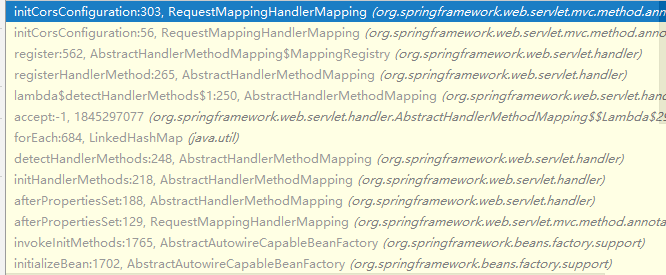现实开发中,我们难免遇到跨域问题,以前笔者只知道jsonp这种解决方式,后面听说spring只要加入@CrossOrigin即可解决跨域问题。本着好奇的心里,笔者看了下@CrossOrigin 作用原理,写下这篇博客。
先说原理:其实很简单,就是利用spring的拦截器实现往response里添加 Access-Control-Allow-Origin等响应头信息,我们可以看下spring是怎么做的
注:这里使用的spring版本为5.0.6
我们可以先往RequestMappingHandlerMapping 的initCorsConfiguration方法打一个断点,发现方法调用情况如下

如果controller在类上标了@CrossOrigin或在方法上标了@CrossOrigin注解,则spring 在记录mapper映射时会记录对应跨域请求映射,代码如下
RequestMappingHandlerMapping
protected CorsConfiguration initCorsConfiguration(Object handler, Method method, RequestMappingInfo mappingInfo) {
HandlerMethod handlerMethod = createHandlerMethod(handler, method);
Class<?> beanType = handlerMethod.getBeanType();
//获取handler上的CrossOrigin 注解
CrossOrigin typeAnnotation = AnnotatedElementUtils.findMergedAnnotation(beanType, CrossOrigin.class);
//获取handler 方法上的CrossOrigin 注解
CrossOrigin methodAnnotation = AnnotatedElementUtils.findMergedAnnotation(method, CrossOrigin.class);
if (typeAnnotation == null && methodAnnotation == null) {
//如果类上和方法都没标CrossOrigin 注解,则返回一个null
return null;
}
//构建一个CorsConfiguration 并返回
CorsConfiguration config = new CorsConfiguration();
updateCorsConfig(config, typeAnnotation);
updateCorsConfig(config, methodAnnotation);
if (CollectionUtils.isEmpty(config.getAllowedMethods())) {
for (RequestMethod allowedMethod : mappingInfo.getMethodsCondition().getMethods()) {
config.addAllowedMethod(allowedMethod.name());
}
}
return config.applyPermitDefaultValues();
}将结果返回到了AbstractHandlerMethodMapping#register,主要代码如下
CorsConfiguration corsConfig = initCorsConfiguration(handler, method, mapping);
if (corsConfig != null) {
//会保存handlerMethod处理跨域请求的配置
this.corsLookup.put(handlerMethod, corsConfig);
}
当一个跨域请求过来时,spring在获取handler时会判断这个请求是否是一个跨域请求,如果是,则会返回一个可以处理跨域的handler
AbstractHandlerMapping#getHandler
HandlerExecutionChain executionChain = getHandlerExecutionChain(handler, request);
//如果是一个跨域请求
if (CorsUtils.isCorsRequest(request)) {
//拿到跨域的全局配置
CorsConfiguration globalConfig = this.globalCorsConfigSource.getCorsConfiguration(request);
//拿到hander的跨域配置
CorsConfiguration handlerConfig = getCorsConfiguration(handler, request);
CorsConfiguration config = (globalConfig != null ? globalConfig.combine(handlerConfig) : handlerConfig);
//处理跨域(即往响应头添加Access-Control-Allow-Origin信息等),并返回对应的handler对象
executionChain = getCorsHandlerExecutionChain(request, executionChain, config);
}我们可以看下如何判定一个请求是一个跨域请求,
public static boolean isCorsRequest(HttpServletRequest request) { //判定请求头是否有Origin 属性即可 return (request.getHeader(HttpHeaders.ORIGIN) != null); }
转自:https://www.liangzl.com/get-article-detail-114619.html